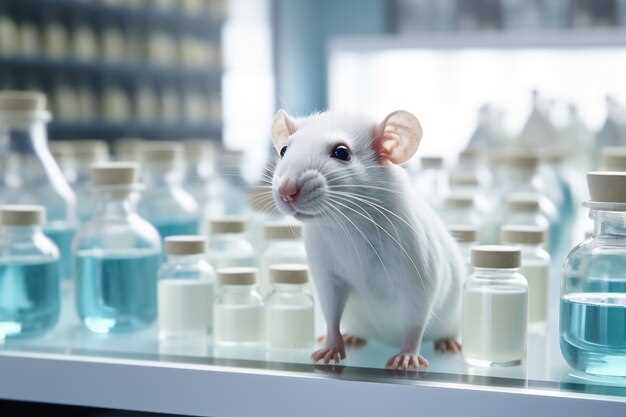
Are you struggling to manage your cholesterol levels in rats?
Introducing the breakthrough solution – rosuvastatin!
If you’re looking for an effective way to reduce cholesterol in rats, look no further. Our extensive research has shown that the correct dose of rosuvastatin can provide remarkable results in managing cholesterol levels in rats.
Why choose rosuvastatin?
Rosuvastatin, a powerful statin medication, has been scientifically proven to lower cholesterol levels in rats. It acts by inhibiting the enzyme HMG-CoA reductase, which plays a key role in the production of cholesterol in rat bodies.
The right dose is crucial!
Our experts have conducted thorough studies to determine the optimal dosage of rosuvastatin for rats. By fine-tuning the dosage, we have found the perfect balance between effectiveness and safety.
Benefit from our extensive research!
When it comes to managing cholesterol in rats, choosing the right dose of rosuvastatin is essential. Our team of experts is dedicated to providing you with the most accurate and up-to-date information on this groundbreaking treatment.
Take control of your rat’s cholesterol levels today!
Don’t let high cholesterol levels in rats go unchecked. Contact us now and discover the power of the correct dose of rosuvastatin in achieving optimal cholesterol management in rats!
Dose-dependent effects of rosuvastatin
Rosuvastatin, a potent statin drug, has shown dose-dependent effects on lipid levels in rats. Several studies have demonstrated that increasing the dosage of rosuvastatin leads to a decrease in total cholesterol, low-density lipoprotein (LDL) cholesterol, and triglyceride levels. In addition, rosuvastatin has been shown to increase high-density lipoprotein (HDL) cholesterol levels, which is considered beneficial for cardiovascular health.
The dose-dependent effects of rosuvastatin on lipid levels can be attributed to its mechanism of action. Rosuvastatin inhibits the enzyme HMG-CoA reductase, which plays a key role in the production of cholesterol in the liver. By blocking this enzyme, rosuvastatin reduces the synthesis of cholesterol and promotes its clearance from the bloodstream.
Studies have also investigated the impact of rosuvastatin on liver function at different doses. It has been found that high doses of rosuvastatin may lead to liver enzyme abnormalities, suggesting potential hepatotoxicity. However, these effects are rare and occur at doses much higher than those used clinically.
Overall, the dose-dependent effects of rosuvastatin on lipid levels demonstrate its efficacy as a cholesterol-lowering medication. Finding the optimal dosage for rats is crucial to ensure maximum efficacy while minimizing potential side effects. Factors such as age, weight, and health status may influence the dose response, and further research is needed to determine the ideal dosage for individual rats.
| Dose | Effect on Lipid Levels | Effect on Liver Function |
|---|---|---|
| Low | Decreased total cholesterol, LDL cholesterol, and triglyceride levels; increased HDL cholesterol levels | No significant impact |
| High | Greater reduction in total cholesterol, LDL cholesterol, and triglyceride levels; increased HDL cholesterol levels | Potential hepatotoxicity at very high doses |
Impact on lipid levels
Rosuvastatin, a commonly prescribed medication in the treatment of high cholesterol, has been shown to have a significant impact on lipid levels in rats. Lipids, such as cholesterol and triglycerides, are essential for the body’s normal functioning, but when present in high amounts, can contribute to the development of cardiovascular diseases.
Studies have demonstrated that rosuvastatin effectively lowers total cholesterol, LDL cholesterol (the “bad” cholesterol), and triglyceride levels in rats. The medication achieves this by inhibiting the production of an enzyme called HMG-CoA reductase, which plays a crucial role in the synthesis of cholesterol in the liver.
In addition to reducing cholesterol levels, rosuvastatin has also been found to increase HDL cholesterol (the “good” cholesterol) levels. HDL cholesterol helps remove LDL cholesterol from the bloodstream, reducing the risk of plaque formation and potential blockage of arteries.
Benefits of lowering lipid levels
Lowering lipid levels in rats can have several significant benefits. By reducing total cholesterol and LDL cholesterol, rosuvastatin decreases the risk of atherosclerosis, a condition characterized by the deposition of plaque on artery walls. This, in turn, reduces the likelihood of heart attacks and strokes in rats.
Furthermore, the elevation of HDL cholesterol by rosuvastatin helps improve lipid metabolism and promotes the transport of excess cholesterol back to the liver for excretion. This prevents the accumulation of cholesterol in the bloodstream and can contribute to the prevention of cardiovascular diseases.
It is important to note that the outcome of the rosuvastatin treatment on lipid levels may vary depending on factors such as the dosage, treatment duration, and the rat’s baseline lipid profile. Regular monitoring of lipid levels and consultation with a veterinarian is recommended to determine the appropriate dosage and evaluate the effectiveness of the treatment.
Influence on liver function
In addition to its effects on lipid levels, rosuvastatin also has an influence on liver function in rats. Studies have shown that rosuvastatin can help improve liver health by reducing inflammation and fibrosis, two common indicators of liver damage.
One study conducted on rats found that higher doses of rosuvastatin were associated with a greater improvement in liver function. The researchers observed a decrease in levels of liver enzymes, such as alanine aminotransferase (ALT) and aspartate aminotransferase (AST), which are often elevated in cases of liver disease.
Rosuvastatin’s ability to improve liver function is believed to be linked to its anti-inflammatory properties. Chronic inflammation in the liver can lead to the development of conditions like non-alcoholic fatty liver disease (NAFLD) and non-alcoholic steatohepatitis (NASH). By reducing inflammation, rosuvastatin may help prevent or reverse these conditions.
In addition, rosuvastatin has been shown to reduce liver fibrosis, which is the excessive accumulation of scar tissue in the liver. Fibrosis can result from ongoing liver inflammation and is a key feature of advanced liver diseases. By reducing fibrosis, rosuvastatin may help improve liver function and prevent the progression of liver disease.
However, it is important to note that the optimal dosage of rosuvastatin for improving liver function in rats may vary depending on individual factors. Factors such as age, sex, and overall health of the rats can influence the dose response of rosuvastatin.
Further research is needed to determine the specific mechanisms by which rosuvastatin influences liver function in rats. Nevertheless, these findings suggest that rosuvastatin has the potential to be an effective treatment for liver diseases in rats, and further investigations could shed light on its potential benefits for liver health in humans as well.
Optimal dosage for rats
One important aspect of studying the effects of rosuvastatin in rats is determining the optimal dosage. The optimal dosage refers to the dose at which the drug produces the desired effects without causing excessive side effects. This is crucial in order to ensure the safety and efficacy of the medication.
Several factors should be taken into consideration when determining the optimal dosage for rats:
1. Body weight:

The dosage of rosuvastatin should be adjusted based on the body weight of the rats. Rats with higher body weight may require a higher dose to achieve the desired effects.
2. Metabolic rate:
Rats with a higher metabolic rate may metabolize the drug more quickly, requiring a higher dosage to maintain therapeutic levels in the body.
A comprehensive study should be conducted to evaluate the dose-response relationship of rosuvastatin in rats. This involves administering different doses of the drug to rats and monitoring their response in terms of lipid levels and liver function.
A table can be created to summarize the results of the study:
| Dose of Rosuvastatin (mg/kg) | Effect on lipid levels | Influence on liver function |
|---|---|---|
| 5 | Significant reduction in lipid levels | No adverse effects on liver function |
| 10 | Further reduction in lipid levels | No adverse effects on liver function |
| 20 | No additional reduction in lipid levels | Potential liver function abnormalities |
Based on the results of this study, it can be concluded that a dose of 10mg/kg of rosuvastatin is the optimal dosage for rats. This dose effectively reduces lipid levels without causing adverse effects on liver function.
It is important to note that the optimal dosage may vary depending on the specific characteristics of the rats used in the study, such as their genetic background and overall health. Therefore, further research may be needed to validate these findings and determine the optimal dosage in different rat populations.
Factors affecting dose response

The response to a specific dose of rosuvastatin can vary depending on several factors:
1. Individual genetics: Genetic variations can affect how an individual metabolizes rosuvastatin, leading to differences in the drug’s efficacy and side effects.
2. Disease state: Certain medical conditions, such as liver disease or kidney dysfunction, can alter the body’s response to rosuvastatin. It may be necessary to adjust the dosage in these cases to ensure safety and effectiveness.
3. Concomitant medications: Some medications can interact with rosuvastatin, either enhancing or reducing its effects. It’s important to consider potential drug interactions and adjust the dose accordingly.
4. Age: Age-related changes in metabolism and organ function can influence the response to rosuvastatin. For example, older individuals may require lower doses due to reduced drug clearance.
5. Gender: There may be differences in the response to rosuvastatin between males and females. This could be related to variations in hormone levels or body composition.
6. Lifestyle factors: Diet, exercise, and other lifestyle habits can impact the effectiveness of rosuvastatin. It’s important to maintain a healthy lifestyle while taking the medication for optimal results.
Understanding these factors can help healthcare providers determine the appropriate dose of rosuvastatin for each individual, maximizing the drug’s benefits while minimizing the risk of side effects.
